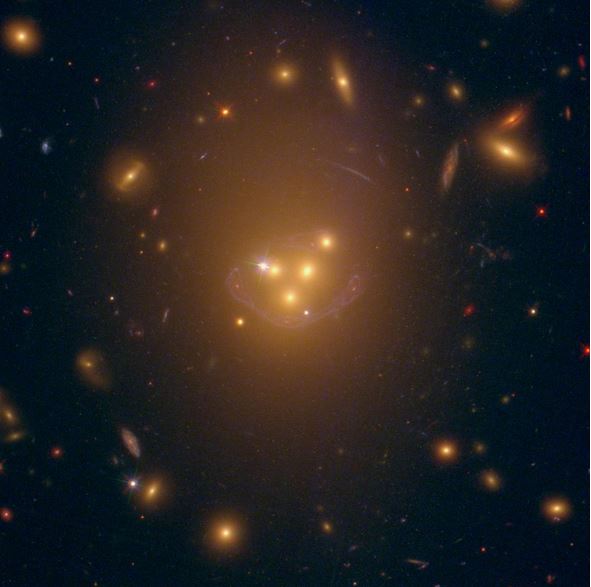Signs of dark matter possibly interacting with a force other than gravity have been observed by an international team of scientists from the UK, US, Switzerland, South Africa, France, and Belgium, led by researchers at Durham University in England.
They made the discovery using the European Southern Observatory’s Very Large Telescope and the Hubble Space Telescope to view simultaneous collisions of four distant galaxies at the center of a galaxy cluster 1.3 billion light years from here.
Dr Richard Massey, Royal Society Research Fellow in Durham University’s Institute for Computational Cosmology, and colleagues wrote in the journal Monthly Notices of the Royal Astronomical Society (citation below) that one dark matter clump seemed to be lagging behind the galaxy it surrounds.

An approximately real-color image from the Hubble Space Telescope, of galaxy cluster Abell 3827. (Dr. Richard Massey Durham University)
According to the scientists, the clump was currently offset from its galaxy by about 50,000 million million kilometres (5,000 light years) – a distance NASA’s Voyager spacecraft would take 90 million years to travel.
This type of offset is predicted during collisions if dark matter interacts, even slightly, with forces other than gravity.
Extra friction would slow down dark matter
According to computer simulations, the additional friction from the collision would slow the dark matter down, eventually making it lag behind.
Astrophysicists believe that all galaxies lie within clumps of dark matter. They are called ‘dark’ because they say it only interacts with gravity and cannot be seen.
Without the constraining effect of dark matter’s extra gravity, galaxies such as ours would not spin, they would simply fling themselves apart.
In this latest study, the scientists could ‘see’ the dark matter clump because of its distorting effect on the light from background galaxies – an effect known as gravitational lensing.
The authors believe their finding potentially rules out the standard theory of Cold Dark Matter, where dark matter only interacts with gravity.
Dr. Massey said:
“We used to think that dark matter sits around, minding its own business. But if it slowed down during this collision, this could be the first dynamical evidence that dark matter notices the world around it.”
“Dark matter may not be completely ‘dark’ after all.”
While they appear to have observed the offsetting of dark matter, the authors note that further studies will be required into other potential effects that might also produce a lag between the dark matter and the galaxy within it.
They add that similar studies of more galaxies and computer simulations of galaxy collisions are currently underway to confirm the interpretation.
Co-author, Lilya Williams, from the University of Minnesota, said:
“Our observation suggests that dark matter might be able to interact with more forces than just gravity.”
“The parallel Universe going on around us has just got interesting. The dark sector could contain rich physics and potentially complex behaviour.”
In March 2015, Dr. Massey and team published observations showing that dark matter hardly interacted with anything during 72 collisions between galaxy clusters (those containing up to 1,000 galaxies).
This latest study looked at the motion of individual galaxies. Astrophysicists say the collision between they galaxies may have lasted longer than those observed in the previous study – allowing even a small frictional force to accumulate over time.
The two results, taken together, bracket the behaviour of dark matter for the first time. Dark matter interacts more than this, but less than that.
Dr. Massey said:
“We are finally homing in dark matter from above and below – squeezing our knowledge from two directions. Dark matter, we’re coming for you.”
The study was funded by The Leverhulme Trust, the Science and Technology Facilities Council, and the Royal Society.
Citation: “The behaviour of dark matter associated with four bright cluster galaxies in the 10 kpc core of Abell 3827,” Richard Massey, Liliya Williams, Renske Smit, Mark Swinbank, Thomas D. Kitching, David Harvey, Mathilde Jauzac, Holger Israel, Douglas Clowe, Alastair Edge, Matt Hilton, Eric Jullo, Adrienne Leonard, Jori Liesenborgs, Julian Merten, Irshad Mohammed, Daisuke Nagai, Johan Richard, Andrew Robertson, Prasenjit Saha, Rebecca Santana, John Stott and Eric Tittley. Monthly Notices of the Royal Astronomical Society. Published 14 April, 2015. DOI: 10.1093/mnras/stv467.

